3 Things to focus your Content on in 2022
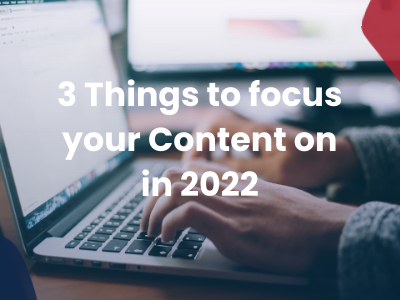
The end of the year always provides such a good time to reflect on trends and the direction we’re going! After a year with so many transitions across industries, privacy laws, and marketing channels, our focuses for next year have also shifted! One area to focus on in 2022 is content marketing.
If these last few years have taught us anything, it’s that content-based marketing really is one of the most important pieces of marketing. Your approach to content informs many aspects of business, not just marketing. Content covers all the ways you communicate. It’s tied to branding and mission and purpose and your focus. The type of content you produce helps you make decisions about marketing channels and our audience.
Content Trends 2022
With the rise of content marketing, ecommerce, and digital advertising, everyone acknowledges that social media, blogs, email marketing, etc. are all effective ways to sell people. The problem is that the very nature of content marketing erases the lines between education, entertainment, and sales. We have become so inundated with ads that our brains have been conditioned to go on the defensive when we feel like we are being sold.
An often-quoted marketing research study from 2007 found that the average American saw 5,000 advertisements a day. 5,000 ads a day pre-digital billboards, pre-Farmville, pre-Instagram, and pre-iPhone. Current estimates put the average number ads seen every day closer to 10,000. The 2007 study warned that number of ads cluttering our life would push for innovation in advertising that would in turn, create more clutter.
What can we do to cut through the clutter in 2022? Content marketing is an effective way because if done well, isn’t actually an ad and will actually reach the consumer.
Here’s three trends/focuses to incorporate into your 2022 content marketing.
Storytelling
This ties into the old writing rule: show don’t tell. Telling a customer how great you are won’t make them believe you. Showing them will prove it to them. But weaving a story around your product, brand, and successes will build an emotional connection between you and your customers.
Education
This goes hand in hand with storytelling and the inundation of advertising we all deal with. We have an excessive number of options to choose from. As well as our personal connection with brands, we use things like Social Proof to help us decide what products to buy. Brands can use this to their advantage by educating customers about their product instead of selling their product. The focus on pure information takes the pressure off the consumer to purchase. In turn, an educated customer is more likely to purchase.
Personalization
Even with increased privacy and data laws, there is more access to information about customers than ever. We often talk about personalized advertising in connection with retargeting and audience segmentation. It’s easy with personalization to focus on how specific and personalized you can get your advertising. ‘If someone clicks this and this and lives in these areas then we know all of this about them and can serve an ad for this specific product.’ That type of thinking is very valuable and helps you communicate effectively with your customers.
But personalized advertising doesn’t need to be that minute; it can be as simple as thinking about what channel you are using. Are you making blog content? What type of person reads blogs? You could build out a detailed buyer persona based on analytics and write with them in mind. That is very personalized! Or you could use common sense to tell you that most people who read blogs are probably interested in educating themselves, which also gives you a lot of information to personalize. The personalization can just be the focus of the channel. ‘These consumers are here to be educated, so we are going to educate them.’
Spotlighted Marketing Channel: CTV
Many marketers are using CTV (connected TV) or OTT (over-the-top) channels to target consumers using streaming services and connected TV devices such as Hulu and Roku. Advertisers are embracing these platforms as more and more ad space becomes available. Spending for CTV advertising grew from $6.94 billion in 2019 to $8.88 billion in 2020, a 28% increase.
Advertiser spent an estimated $8.88 billion on CTV in 2020
Read more about the future of CTV here!
What things are you excited to focus on in 2022?
It’s Holiday Campaign Time… Already
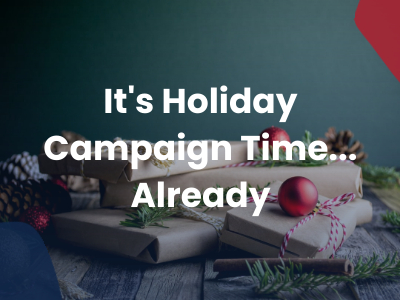
55% of consumers say that they will start their holiday shopping before Halloween this year. This means, the holiday season is here early! Consumers are worried about increased shipping times and product outages, pushing them to get their shopping done early. Americans are also expected to spend 7%-9% more this holiday season! What do you need to get your Holiday campaign set up on time?
Supply Chain and Shipping Issues
Pandemic-related shipping delays have gotten a lot better this year, but many companies are expecting large delays, due to volume, this holiday season. Also, many shipping companies’ deadline for Christmas deliveries is earlier this year. For example, FedEx’s Economy deadline is December 9th, UPS is December 16th, and USPS is the 15th. USPS also updated Holiday pricing this week on October 3rd.
Just about every part of the supply chain has been disrupted. There’s a shortages of factory workers, shortages of cargo ships and containers, large scale storms, a lack of truck drivers and warehouse employees, and retail workers. Big companies like Nike, H&M, and Ikea have already been affected.
What does this mean for you?
The best time to get started on your holiday campaign is RIGHT NOW. Especially if you are a small business; take advantage of all those big companies’ supply chain issues!
Good campaigns take time to set up and the sooner you can get your message out, the better. In the past the rule of thumb has been to have your campaign live by November 19th; however, a lot of brands have already started easing into their holiday campaigns. (Looking at you, Pottery Barn.)
What do you need to set up your holiday campaign?
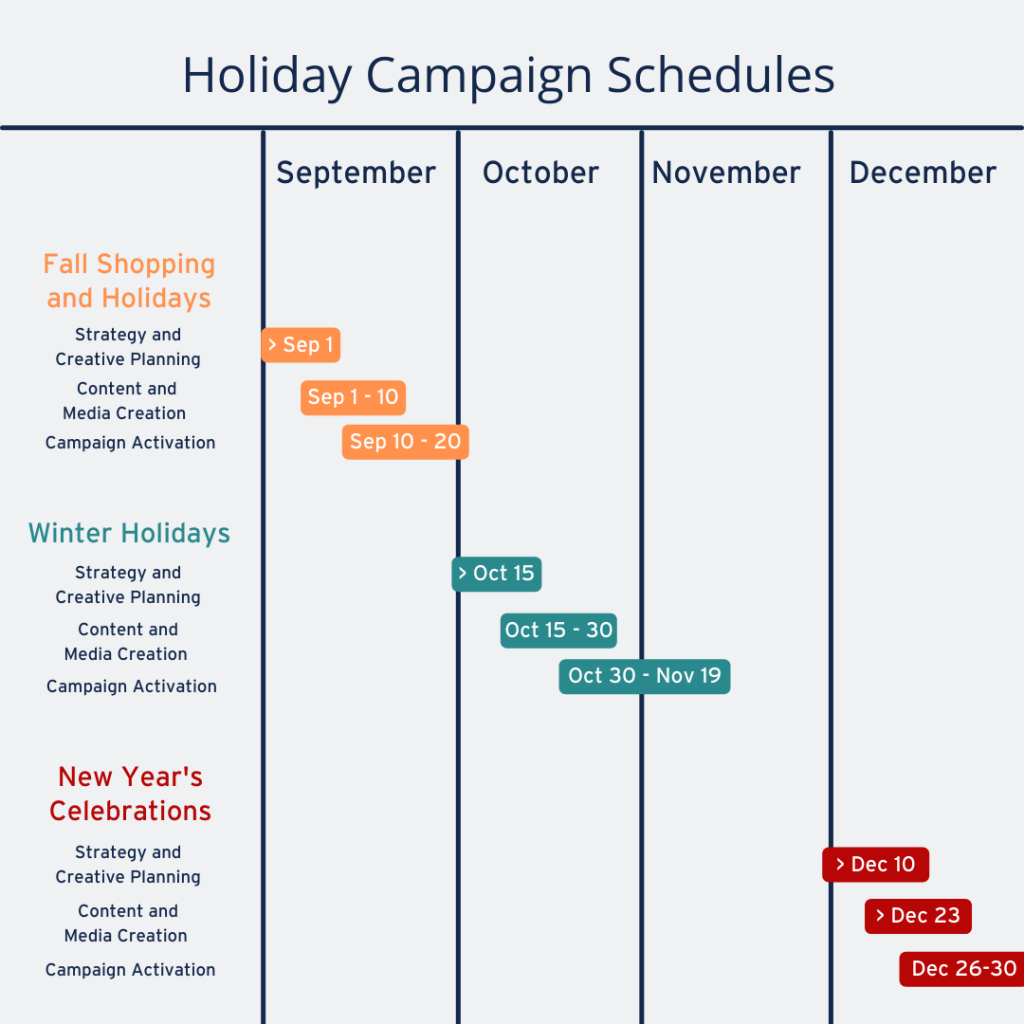
Step 1. Have a plan! That’s why it’s a campaign and not just content! A strategy is key! How do you know what should be holiday 2021 strategy? Start by asking the “why.” Why are you doing a holiday campaign in the first place? Do you have an awesome product that a lot of people would love? The next step is the campaign objectives. What do you want to specifically do you want to accomplish with this campaign? Are you trying to build brand awareness, drive traffic, or sell a specific product? Once you know what you want to accomplish, the next step is to figure out what channels and methods would be the most effective way to reach your audience.
All of these things are your strategy: the why, the what, and the how.
The next step to planning a campaign is content and message. You know what your goal is, now you make the creative that goes with it. Whether that be social content, print and mail, or digital ads, or hopefully, some combination of all the channels!
After putting your campaign out into the world, the next step is to learn. This is the data gathering and retargeting phase. A one step campaign isn’t going to be as effective as a campaign that customers on a journey.
Marketing Channel highlight: TikTok
TikTok is going to be a powerful channel this holiday season. 47% of surveyed TikTok users said that TikTok is likely to inspire a gift this year. 39% said that they discovered a product or brand on TikTok, and 77% said that they have bought things because of TikTok. TikTok is also offering incentives for advertisers to use their platform.
Do you have your holiday campaign ready to go?
What is the value of companies promoting Flow State?

With many companies adjusting to being back in the office or a hybrid work model, employees are having to change their Flow State. What is a Flow State? (Sometimes just called Flow.) Flow is simply that state of mind in which we feel and perform our best and feel at ease. We all have systems or processes that make it naturally easier for us to access Flow. We can, however, also we can take steps that can allow us to access it.
Switching up work environments over the past year and a half has facilitated many employees having to adjust how the access their Flow State. What is the value of companies promoting Flow State? How has the changing work model impacted Flow? And how can you access your Flow State and increase productivity?
What is Flow?
Your Flow State is what is happening mentally when you are “in the zone.” It’s being fully engaged in a task. Flow was first identified and popularized by psychology researcher, Mihaly Csikszentmihalyi, from Claremont Graduate University in California. Everyone’s Flow State is different is directly connected to their effort and creativity. When you are in your Flow State, you brain is locked into process and knows exactly what it is going to do from one moment to the next.
What is the value of companies promoting Flow State?
Flow State sounds abstract and kind of like a fuzzy motivation tool. How can it actually benefit companies? The main way is that when employees are in their Flow State, they are doing their best work. Not only that, employees who work in a Flow State often gain greater satisfaction from their work and a that contributes to motivation and company loyalty. While working in a Flow State, employees have more concentrate and focus and therefore, less distractions. The clarity that comes form that leads to innovation. All of these things are qualities that make up exceptional employees.
Flow State can be broken by distraction. Employee distraction is also detrimental to companies. Microsoft’s 2020 WFH study found that before the pandemic, on average, workers felt like 52% of their day was wasted by distractions and unnecessary disturbances. A 2013 study found that employees who were frequently interrupted and dealt with a lot a distractions reported higher fatigue and burnout rates. Burnt out employees are more likely to make mistakes, call in sick, as well as look for new jobs. (As we’ve seen this year with The Great Resignation.)
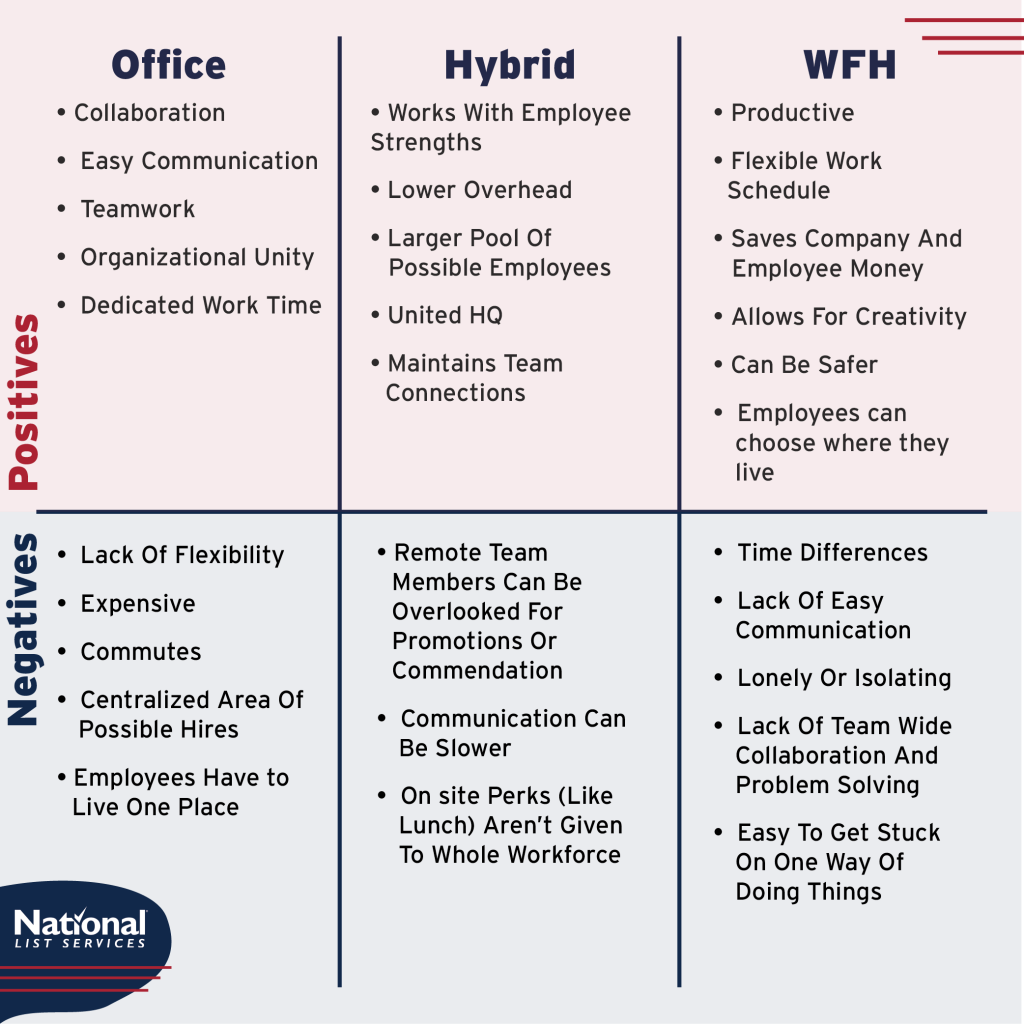
How has the changing work model impacted Flow?
One of the main advantages to a hybrid work model or allowing employees to choose weather or not they WFH, is that help each employee work in an environment that best suits them. Some employees can tap into their Flow State best in a quiet, comfortable space; weather that be at home or in the office, free of home’s distractions such as children or pets. Others like the background noise of a coffee shop. Some enjoy the collaboration of working in the office and having coworkers around them.
This year has given a lot of people an opportunity to find which type of work environment actually works best for them. Of the over 1,200 employees and 133 executives surveyed in Microsoft’s WFH study at the end of last year, 55% said they would prefer to still work remotely at least 3 days a week. And before this past year, many of those people probably wouldn’t have been given the chance to know what work environment worked best for them.
And how can you access your Flow State and increase productivity?
Here are the 2 main steps needed to tap into your flow state.
- First, you must observe yourself. For the next two weeks, observe yourself, notice what you’re doing, and look for the clues of flow: losing your sense of time or self, feeling that you’re acting with ease, gaining new insights, and having a positive feedback loop.
- Then, when you are in a state of flow, broaden your awareness: Notice and remember the activities surrounding you. Recognize what you’re physically doing and think about what you’re doing mentally.
What ways have you found to be effective in “getting in the zone” and accessing your Flow State?
What’s new in TV marketing?
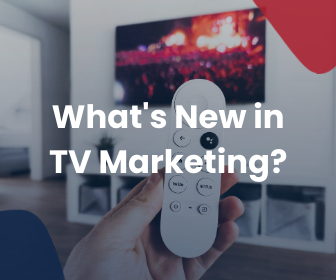
One thing that stays constant, even in the midst of challenging circumstances such as a pandemic, is that people consume media. We always seek out entertainment and information. Content consumption is at an all-time high and therefore, competition for viewer’s attention is as well. However, 84% of marketers say that it is getting harder to grab a consumer’s attention with television advertising alone. Most advertisers surveyed say that TV ads isn’t the first thing that they plan anymore, instead starting with digital and then working in TV. How can CTV and OTT change that?
CTV and OTT
Many marketers are using CTV (connected TV) or OTT (over-the-top) channels to target consumers using streaming services and connected TV devices such as Hulu and Roku. Advertises are embracing these platforms as more and more ad space becomes available. Spending for CTV advertising grew from $6.94 billion in 2019 to $8.88 billion in 2020, a 28% increase.
Advertiser spent an estimated $8.88 billion on CTV in 2020
What’s the difference between CTV and OTT? Connected TV are things like Apple TV and Amazon Firestick. It is marketing based on the devices used to connect users to TV without cable. Over the Top is advertising space found on streaming services, like hulu and Peacock. (Personally, it helps me to think of them like CTV is hardware and OTT is software.) Right now in the United States more people are reachable through CTV and OTT than with cable. Hulu alone made $3 billion in ad revenue last year!
Disadvantages?
What are some disadvantages? There is one main thing. CTV and OTT have lower engagement rates than people who come from digital advertising expect. Why? Well, theres no way to click or show engagement through your TV. For the consumer to follow through a call-to-action, they probably are going to use a different device. Cross device traffic is harder to push and harder to track.
With old school TV advertising, an ad’s effectiveness was tracked by seeing if sales went up in the area the ad played. Thats just not enough data now, especially if CTV/OTT is just a piece of a multichannel campaign. It’s important to be able to track every part of a campaign.
Tracking Options
Option 1: Use IPs. Most people make big purchases on their home wifi. Using retargeting and IP based cookies, it’s pretty simple to serve ads across devices.
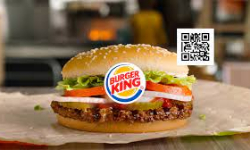
Option 2: Use, specific trackable call-to-actions. Building in gamification to CTV/OTT ads allows consumers to use their phones to follow the call-to-action. The QR-code Burger King ad is a fantastic example of this. In a CTV ad, Burger King challenged consumers to “catch” a moving QR code. If you caught the QR code, it took you to download their app and with the app download, they gave you a free Whopper. It was fun and engaging AND trackable.
Into the Future
Since CTV/OTT is a relatively new ad format, theres a lot new and exciting ways it can be used in the future!
- New ad formats.
We will probably see more direct response ads like the Burger King one. As well as things like pause ads. Ads the are promoted when a users pauses the program. A great way some companies are starting to use this is thinking about why someone would need to pause the show. Are they hungry? How about an Uber Eats ads? Or do they need a bathroom break? Maybe a toilet paper ad?
Another new ad format is contextual-in-show advertising. A billboard in the background of a show can be sold as ad space. It can be changed based on who is watching the show. - Programmatic Linear TV is also starting to become more of an option. Although quite new, it’s becoming more possible to use Nielsen-based user-level data (age, demographic, income) or media-level targeting (show, part of day, network) to inform programmatic style ad spend for traditional linear TV. 20% of advertisers surveyed said that they planned to incorporate programmatic linear into their marketing plans this year, and another 20% said that while they aren’t incorporating it this year, they plan to in the near future.

How will TV advertising change in the future? It’s possible that as CTV and OTT take over the traditional TV space household level targeting such as IP address and Neilson style demographics will become the identification of choice for marketers looking to incorporate TV into their omnichannel campaigns.
Using new tools and integrating in traditional ones, marketers will be able to effectively use TV in their campaigns on into the future!
Get the most out of Instagram – How?
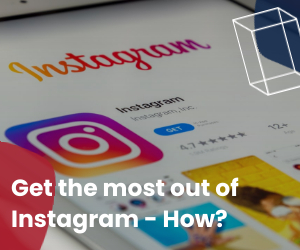
Instagram can be a confusing and overwhelming beast. It has its own constantly changing algorithm and culture that separates it from any other social media. Getting Instagram to work for you takes time, effort, insight, and unfortunately: intuition. What do you need to get the most out of Instagram?
Being an Instagram pro requires knowledge of 3 things: its culture, its algorithm, and your own analytics of those 2 things. Understanding the culture and the algorithm don’t do you much good if that knowledge is disconnected from your own follower and user data.
Instagram Culture
The biggest thing to remember is that Instagram is not Facebook. Facebook is for information, Instagram is for connections. And Instagram’s user base is generally younger than its big brother Facebook. More than 50% of Instagram users are between 18-35, while more than 60% of Facebook’s user are over 35. Therefore, these users have grown up with social media, including Instagram, and have shaped its function and culture. (For example, by the time my friends and I were old enough to have social media, Facebook was already too big and felt like something elusively for our parents. For a long time, Instagram was the only social media any of us had.)
Although Instagram is great for showing off products, the thing it is best at is highlighting your brand’s culture and personality. It is not enough anymore to have a good product available anymore, your consumers need to feel connected to your brand. 56% of Gen Z consumers say that having shared passions and perspectives is a major factor when it comes to their engagement with a brand.

And 49% of young consumers say they will evangelize a brand they feel represents their values, likes, and personality.
Don’t be afraid of incorporating causes you care about into your brands personality! 72% of consumers want the brands they care about to be positive contributors to society. We’ve seen in recent years that many brands (especially smaller companies) connect their core brand to a charity or cause they care about. Younger consumers are 69% more likely to buy from a brand that contributes to a cause.
The Algorithm
According to Instagram, they decide to show your content based on 6 factors:
#1: Interest
#2: Relationship
#3: Timeliness
#4: Frequency
#5: Following
#6: Usage
The first three are somewhat self-explanatory. Instagram shows you things based on what you’ve liked in the past. They highlight posts from people they’ve decided are close to you: people whose content you most engage with, the people who tag you, the people you DM etc. Instagram also cares about when you post. Keeping track of your analytics can give you a good idea about when the best times to post for you are.
#4 Frequency

Frequency isn’t about how often you post but instead about how often interact with the app. The more often you check your Instagram feed the more likely your feed will be chronological because they are always trying to show you the newest content available. This is helpful to understand what type of Instagram users your followers are. If they don’t check the app that often, then it will be harder to have your posts seen. Building up the other 5 components to the algorithm will be all the more important.
#5 Following
Instagram assigns value to follower counts in a couple different ways. First, is simple: the more followers you have the more likely your posts will be highlighted in your follower’s feeds. However, they also look at your follower’s engagement levels. If you have a lot of ghost followers that don’t interact with you, then they could actually be hurting you. Another thing to consider, the more people your followers follow the more competition for space in their feed. Do your followers follow a lot of people? Understanding that can help you decide if you need to adjust where you focus your efforts.
#6 Usage
This is how Instagram qualifies the amount of time spent on the app. The more time spent on the app, the deeper into its catalogs they have to pull from to show content. You can use this to your advantage by using hashtags or developing content that matches with the interests of Instagram’s heavy users.
How do you get the most out of Instagram?
What Can Your Team Do Stay Productive?
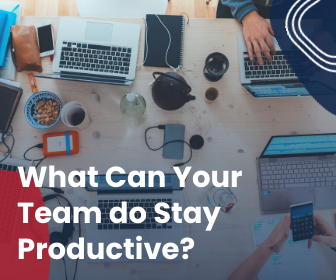
When working as part of a team, how we work alone as well as how we work together contributes to productivity and efficiency. When employees are stressed or exhausted, engagement and productivity dip and the whole company can feel the effects. It can be hard to stay productive.
Managing stress has been a challenge for a lot of people this year. In Asana’s Anatomy of Work 2021 study, 71% of workers said that they felt burnt out at least once in the last year. Also, 42% rated their stress levels as high or very high. 😳
So, what can you as an individual and you as a team do to maintain your efficiency and productivity?
What Can You Do as A Team to Stay Productive?
Unfortunately, work related stress often has to do with environment. When one person is feeling burnt out on your team, it can bring the whole team down. What can you do to create a less stress inducing work environment?
Talk It Out
Ewww, right? However, it’s impossible to know what is wrong or how you can help a situation if you don’t know at the problem is. Take in interest in people you work with. Is there anything going on in their life that might be adding stress? Is a process or workflow just not working for and its making things difficult?
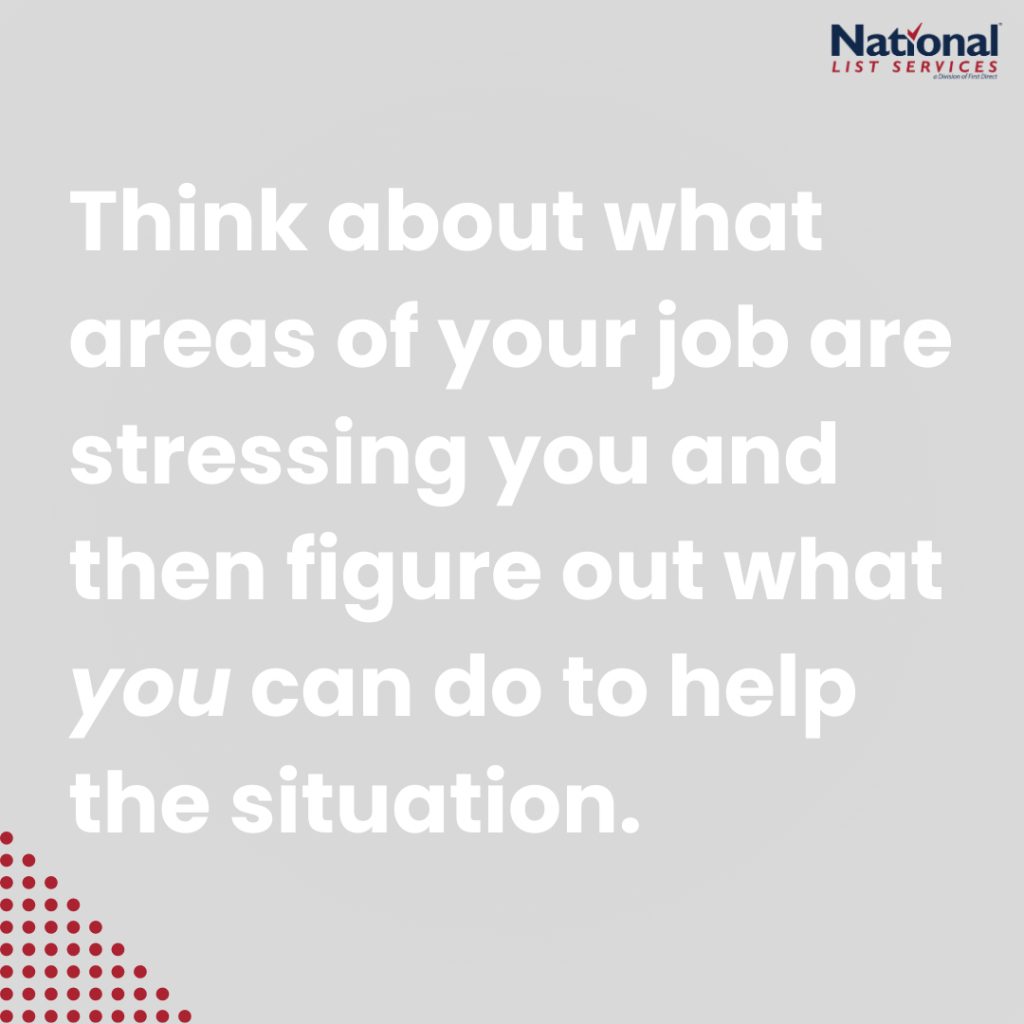
Once you understand how your team is feeling, don’t disregard it! See what you can do to make things run smoother.
Take Control Over Your Situation
We are all responsible for ourselves. If you are lucky enough to have anatomy in your job, use it! Think about what areas of your job are stressing you and then figure out what you can do to help the situation. For example, do you struggle with being productive in the afternoons because you hit a massive exhaustion wall? Could you be hitting that dip because you constantly don’t get enough sleep? Or does coffee make you crash? Those are things that you have control over and can change.
And after this year, more and more companies are realizing that giving their employees flexibility over schedule and in some cases, whether they want to work from home, actually increases productivity!
Minimize Distractions
The Asana study mentioned early found that “work about work” took up 60% of most employee’s days. That “work about work” is things like, meetings about processes, communicating about specific tasks, switching between tools, waiting for apps to load, searching for information, following up with team members about a project’s status, and managing shifted task priorities. A lot of those things are things that you don’t have control over. However, dealing with tasks like that can quickly give you the feeling of being on a work sized hamster wheel. That’s partly because “work about work” doesn’t feel like you are accomplishing anything.
What can help you feel in control? Figure out the right processes and find the right tools. If you can work with your team to put an effective process in place for dealing with collaborative projects. Part of that involves finding the right tools. There are so many workflow and team management tools available now that it shouldn’t be difficult to find one that works for you and your budget. (We are big fans of Teams/Planner and good old fashioned white boards.)
Time Management
Time management single handedly has the biggest impact on work stressor and burn out. Good time management can drastically increase your productivity and give you more time to focus on other aspects of your life. A healthy work-life balance will help aspects of your life, including reducing stress!
Connect Your Targets to Big Goals
Time management is about getting the work done, it about getting the right things done at the time. A big part of understanding and prioritizing what’s most important is know what are your goals. And if you work for a company, what its goals are. A recent study found that only 26% of employees understand how their work relates to the overall company goals. How can you know what daily targets to set if you don’t understand where you are trying to go?
Only 26% of employees understand how their work relates to the overall company goals
This goes back to talk it out. If you have questions, ask! And if you are in a management position, work with your employees so everyone understands what they are doing to help the company reach its goals!
Prioritize and Organize
Its critical to understand what tasks are most important. Inevitably things change throughout the day; deadlines move and priorities shift. If you understand what’s most important in the grand scheme, however, it can make adapting to those changes easier. In the Asana study, they found that 29% of employees cited confusion on task priorities as a contributing factor to their burnout.

There are many different methods to prioritizing and organizing your daily tasks. The “Eat The Frog” method (named after the famous Mark Twain quote) encourages you to take care of the big or complex tasks first thing in the morning. This way you are productive right out the gate and don’t have a big task hanging over your head all day. Once you’ve eaten the frog you can move to other things.
Another popular method is David Allen’s “Getting Things Done” method. The first step in this method is write everything you need to get done down. Once you have an overview it’s easy to see what tasks are important. Writing it all down and putting it one place frees up brain power and lets you focus on actually getting the stuff done.
Plan Ahead
Writing down your targets for the next day before you finish for the night or as you think of it, helps you feel on top of the day as soon as it starts. Spending a few minutes to plan out tomorrow’s tasks is way easier than spending the first part of your day scrambling to remember what was a priority to get done that day. This will also help your work life balance because you don’t have to keep thinking about all you have tomorrow.
Say “No” or Delegate
This is a struggle, we know. But one advantage of having clear, prioritized tasks, is that you can see when a task is not a priority or not one you have time for. It’s easier to explain why you are saying no if everyone knows what your current priorities are. Sharing your clearly defined priorities with your team gives everyone more clearly. This is something that we have found to be successful. In our morning meeting we often go through what everyone’s priority tasks for the day are. By doing this, we know what each of us needs to be focusing on and how much a priority it is to reach our company goals. It also makes it easier to see where we could help.

Knowing what your team’s priorities are, can also make it easier to delegate tasks. Just because something is a priority task for you doesn’t mean it’s not important! Help it get to the right person and that benefits everyone.
Audit Your Tasks
Is there anything on your plate right now that doesn’t align with your goals? Ask yourself, is this task not a priority for today anymore? Or is it not a priority at all? If the task is still important but keeps getting moved to the bottom of your priorities, ask yourself if you are the right person to be handling it?
Another aspect of auditing task is looking at how you view the task. Are you procrastinating the task because you don’t really want to do it? It’s easy to add time to situations if want to avoid the task. However, tasks don’t usually take care of themselves. (wouldn’t that be nice?) procrastinating the task will just make it worse. And often, when we finally do something, we’ve been procrastinating, we find it wasn’t that difficult in the first place!
What have you found successful in dealing with work stress? Any time management tricks you swear by?
How do these marketing channels stack up?
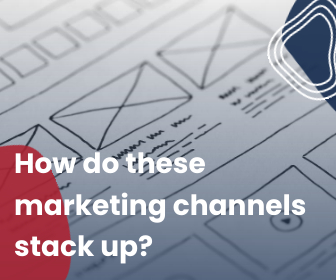
There are A LOT of different marketing channels out there. What are the pros and cons of some of the common ones?
Social Media
Pro
There are over 3.8 billion people on social media around the world. Social media is a fantastic way to connect with customers, build brand loyalty, and generate sales.
People don’t just want to buy from companies because they have good products and services. They want to know what your brand stands for in addition to what it sells. Social media can help potential customers get to you. Social media feel like a 1-on-1 conversation between the brand and consumer, which helps build loyalty.
Con
A lot of the value from social doesn’t show up immediately. It’s rarely simple to track social media’s ROI. Often the goal of social media is not just to generate sales but instead to build connections. Without measurable results, using social media can be discouraging.

Pro
Often it a brand’s only way to communicate with customers and can feel very one on one. A lot of millennial and gen z’ers expect to communicate with brands through email. Also, pretty much everyone has email so you know you will be able to communicate with people through email.
Con
We all get so. many. emails. Most office workers receive 127 every day. It can be hard to stand out from the crowd. People don’t have time to read emails that don’t actually provide them value.
Email marketing also has a lot of laws and rules connected to it that can hurt you if your aren’t careful!
Content/SEO

Pro
Customers often rely on a business’s website for information. Especially for local businesses, it can be the only way to know a shop hours or address. Putting the information on a website instead of a social media or directly in a browser legitimizes the information.
Good SEO gives your website credibility. It makes it easier for people to find your website when they search for it. And it helps create a smoother user experience.
Con
Bad SEO can hurt you. Most searchers never go past the first or second page of Google, though, which is why those top spots in the search results are so coveted. Having the proper SEO can prevent your website form getting organic traffic.
53% of all trackable website traffic comes from organic search. SEO is the main thing influencing how easy it is to find you online organically. Which is probably why it’s estimated that agencies and brands spent over $79.27 Billion on SEO services last year.
Google Ads

Pro
Where are people? On their phones. So, google ads is an extremely effective way to find people where they are. Google ads is great for brand awarness as well as retargeting. It is great if you want measurable results and analytics.
Con
Billboards, signs, posters, newspapers, and magazines all exist with in different physical spaces. With digital advertising however, we are all competing for the same ad space. That ad space is worth more now has less guarantees attached to it.
Trying to figure Google ads can feel like rocket science. There’s a large learning curve and it can a while to feel confident in the set up.
Print and Mail

Pro
Direct mail average open rate is somewhere between 68 and 90%, which is double, triple, or quadruple the average open rates of other marketing channels. Do people who open direct mail actually purchase? Yes! On average people who receive direct mail purchase 28% more items and spend 28% more money!
Why is direct mail so effective? It comes down to fact that we (humans) like getting mail. 41% of Americans of all ages look forward to getting their mail every day. We still want very real things in our hands, which is something totally lost in email inboxes or on social media. That tactile connection translates into 💰.
Con
Since Direct mail requires use of the postal system it has fixed costs. The graphic design of the mail piece may also have an additional cost. Using direct always requires a bit of math and if done wrong can hurt your ROI.
It’s not always posable to see direct, measurable results, from Direct mail campaigns. And if you can measure results, it may take a while to get the full picture.
Another thing that can be a disadvantage to direct mail is that you need a really good foundation of address data. The problem us that a lot of data providers don’t make sure that their data is accurate and that hurts the effectiveness of your campaign.
Connected TV

Pro
TV is a time-tested advertising channel. Although it’s a lot less common than it used to be, it can still be very effective. Many marketers are using CTV (connected TV) or OTT (over-the-top) channels to target consumers using streaming services and connected TV devices such as Hulu and Roku. Advertises are embracing these platforms as more and more ad space becomes available. Spending for CTV advertising is expected to grow from $6.94 billion in 2019 to $8.88 billion in 2020, a 28% increase.
Con
With customer attention spread so thin and cable tv subscriptions consistently falling, (over 16 million in the last five years) there’s a lot less advertising space available. Content consumption is at an all-time high and therefore, competition for viewer’s attention is as well. 84% of marketers say that it is getting harder to grab a consumer’s attention with television advertising alone.
Audiences today expect personalized and relevant targeted ads. Linear TV (cable and network television) often fall far behind in targeting capabilities. Therefore, it can be a challenge for advertisers to figure out how to integrate linear TV into their campaigns.
How to get past creative blocks
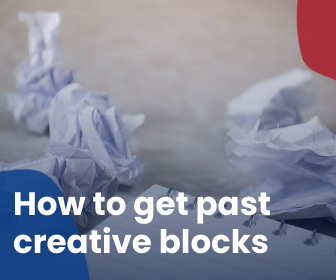
Whether or not you think of yourself as creative person, all jobs required creative thinking. And especially as marketers we produce a lot of content, for ourselves and our clients. However, it can be difficult to continue to produce high-quality content when we don’t feel creative or inspired.
Fortunately, there are things we can do to get over (or prevent) creative blocks.
Take a break
Remember your brain is a muscle and needs rest time. During our break time out brains continue to process ideas. Therefore, breaks can boost our creativity and give us new ideas.
One of the most effective ways to get over a creative break is to take a break outside. The University of Michigan found that walking outside (preferably in nature) improved attention spans and memory performance over 20%! They found that walking outside, no matter the temperature, had the same mental effects as meditation.
Don’t force it
Our brains don’t have an endless well of content ideas. And we can’t force ourselves to be creative. It’s okay to just walk away. One way to keep to refilling the well is to just do something else. Change your scenery, have conversations, read books or articles, watch a movie or show. Diversity of other creative inputs will refill your own creativity.
Inspiration can be found anywhere but it’s easier to find it when you are being active. Take opportunities to use other parts of your brain and senses! It could even be a monotonous task that you normally don’t enjoy, but the switch up will help get the juices flowing.
Focus on the process, not on the results.
Making content isn’t just about the result. There are many steps along the way. Finding joy in all the steps can make it easier to stay motivated.
Befriend your inner critic
There will be bumps in the road. It impossible to make perfect content, the first time, every time. Taking risks will help sharpen your skills and build your confidence. Don’t afraid to befriend your inner critic. Not letting yourself fail or telling yourself that you aren’t able to succeed both result in failure. It ok! Your inner critic and any failure is how you learn and grow. The fast you acknowledge your critic and failure, the faster you’ll be able to get past the block and make something you are proud of. It’s all part of the process!
“It’s through mistakes that you actually can grow. You have to get bad in order to get good.”
Paula Scher
Listen to yourself
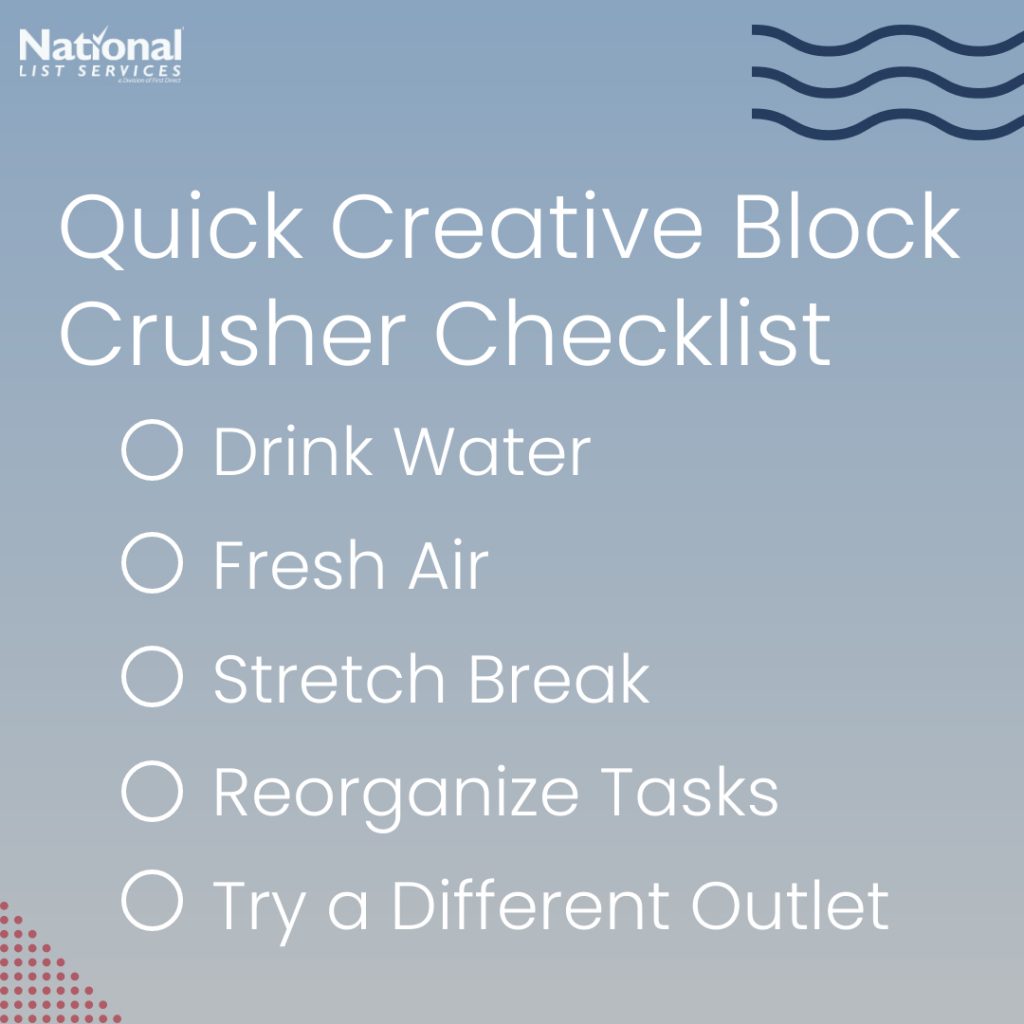
Although it may feel like it, creative blocks don’t just appear out of nowhere. Often, a lack of creativity comes from not taking care of your physical or mental health. It’s difficult to feel motivated and inspired if you’re exhausted.
So, check in on yourself. Are you getting enough sleep? When was the last time you drank water? It’s easy to want to power through and get things done but that mentality will come back to bite you later.
Audit your task list
Sometimes a task can seem so big and overwhelming that it’s hard to know where to start and we just don’t. It can paralyze your creativity. The easiest solution is to organize and prioritize your tasks. Cut the task into smaller chunks if you need to.
Ways to divide tasks
There are many different methods to prioritizing and organizing your daily tasks. The “Eat the Frog” method (named after the famous Mark Twain quote) encourages you to take care of the big or complex tasks first thing in the morning. This way you are productive right out the gate and don’t have a big task hanging over your head all day. Once you’ve eaten the frog you can move to other things.
Another popular method is David Allen’s “Getting Things Done” method. The first step in this method is write everything you need to get done down. Once you have an overview it’s easy to see what tasks are important. Writing it all down and putting it one place frees up brain power and lets you focus on getting the stuff done.
“Great things are not done by impulse, but by a series of small things brought together.”
Van Gogh
Plan ahead
Writing down your targets for the next day before you finish for the night or as you think of it, helps you feel on top of the day as soon as it starts. Spending a few minutes to plan out tomorrow’s tasks is way easier than spending the first part of your day scrambling to remember what was a priority to get done that day. This will also help your work life balance because you don’t have to keep thinking about all you have tomorrow.
Another aspect of auditing task is looking at how you view the task. Are you procrastinating the task because you don’t really want to do it? It’s easy to add time to situations if want to avoid the task. However, tasks don’t usually take care of themselves. (wouldn’t that be nice?) procrastinating the task will just make it worse. And often, when we finally do something, we’ve been procrastinating, we find it wasn’t that difficult in the first place!
What is your go-to way to get past creative blocks?
7 Ways To Make More Engaging Content
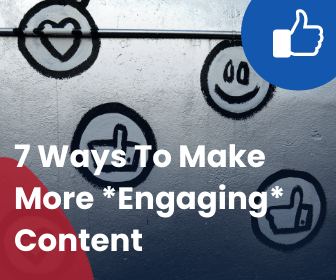
Content creation is an integral part of marketing or running a business in general now. However, a lot of companies struggle with creating content that generates engagement. Part of the value of content creation is that engagement and the conversation between brand and consumer. What can you do to create engaging content for your brand?
Here’s 7 things we have found to be essential in making quality content!
Know Your Audience
The content you create for one audience can be very different from another. Understanding the WHO is helpful first step.
It can also be helpful if you think of your audience as a single composite person. Instead of trying to talk to all of them, you are instead making content for one person. A lot of companies do this by making a buyer persona. That way you can think, “Would my buyer persona like this?” vs. “Would all my followers enjoy this content?”
Make a Plan
There is nothing more overwhelming than trying to maintain consistent content posting across multiple channels without a plan. It can feel like juggling snakes. 🐍 Making a plan can be as simple as figuring out what types of content you want to post and when it would be best to time to post it. The more specific your plan is the more you time you take out of the equation.
Part of making a plan is planning out your message and/or your angle. Now that you know who your audience is, think about what type of content would work best for them. Knowing what you want to talk about can make it easier to figure out what types of content would be best. Would your audience benefit from long form blog articles or would a TikTok series be more helpful? Both of those types of content take a lot of effort, so planning it out ahead of time is valuable!
Find Shared Passions
The sheer amount of product, companies, and information available is staggering. It is not enough anymore to have a good product available anymore, your brand ideals and personality need to match with the personality of your consumers. 56% of Gen Z consumers say that having shared passions and perspectives is a major factor when it comes to their engagement with a brand. However, most consumers are fantastic at sniffing out inauthenticity. Your brand personality and ideals need to actually be what you say they are. Actions speak louder than words!
What are the advantages of having a well-defined brand personality and ideals? Giving your company a personality makes things like content creation a lot easier. Knowing who you are also can help you make decisions about the direction you want to go in the future.
And 49% of young consumers say they will evangelize a brand they feel represents their values, likes, and personality.
Don’t be afraid of incorporating causes you care about into your brands personality! 72% of consumers want the brands they care about to be positive contributors to society. We’ve seen in recent years that many brands (especially smaller companies) connect their core brand to a charity or cause they care about. Younger consumers are 69% more likely to buy from a brand that contributes to a cause.
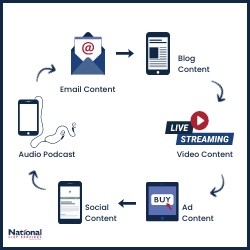
Keep It Simple
Don’t make it harder than it needs to be. No matter who your audience is, needlessly complicated language or content structure isn’t appreciated. Simple and honest is always good. Remember, why you are making the content. Is it to promote you or your brand? Then tone of the content should match your voice. People can see right through any inauthenticity if you are trying to make something that isn’t you.
It’s easier to connect with a brand online if you feel like you are talking to a real person. Does the content you are making sound personal?
Remember the Big Picture
Why do you want to make this content? Keep the big picture of your content in mind as well as each individual piece. Are you trying to promote a specific product or service? Don’t be afraid to include a call to action in your content! A call to action is how to accomplish the goal of your content. It’s the follow through.
A good call to action is simple and concise. It uses strong verbiage. Give your audience a good reason to take the desired action. Don’t be afraid to get creative!
Take a Step Back
When it comes to content, it’s often valuable to take a step back and from your project and let it rest for a bit. The longer you work on a piece of content the easier it is to be become blind to mistakes, errors, and typos. You may be surprised by the power of fresh eyes!
An old copy writer trick is to proofread backwards. Instead of starting at the beginning of your content: start at the end. Because your brain is following a different path through the information, it sees things in a different way. Starting at the end allows you to look at it sentence by sentence instead of word by word or thought by thought. Knowing your content is edited well will help you feel more confident in posting it.
Another aspect of taking a step back from your content is revisiting old content. Repurposing or adapting finished content is an excellent way to stay inspired and make more content. There are always new things that can be added. Adding information keeps your messages up to date. Up-to-date content is more accurate and provides for value to your followers. Another reason to recycle content is that it gives more people an opportunity to see it. And even if someone has been following you for a long time there’s a good chance that they didn’t see the content the first time around.

Keep Consuming Content
This is my favorite part. 😜 One of the best ways to keep your own content sharp is to consume other content. It can inspire you, help you stay up to date with current trends, and keep your skill sharp. Most ideas don’t start in our heads, the spark is external. All of the creative juices it takes to create content can easily be burnt out if you don’t feed it with creative thing that you care about. Change your scenery, have conversations, read books or articles, watch a movie or show. Diversity of other creative inputs will refill your own creativity!
What type of Content have you found to be the most engaging with your audience?
Are these Channels “DEAD?”
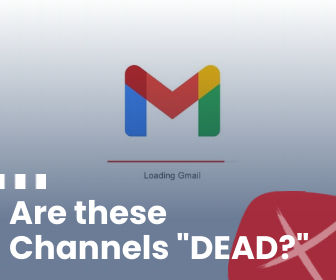
It seems like soooooo many articles/emails/ebooks/Facebook videos are titled something along the lines of: “blank” is dead. Or “Why the new ios update is going to kill email marketing.” Or “3 stats that prove print and mail is dead.” But it is? For the most part those titles are just clickbait, and the content just proves how it is very much not dead.
So, let’s take the three most common “dead” or “dying” marketing channels and see how effective they really are.
Email Marketing
I probably get an email once a week proclaiming the end of email marketing. How can email marketing be “dead?” Statista estimates that close to 320 BILLON emails will be sent every day in 2021. On average, office workers receive 127 every day. And a Forbes article from last year suggested that “every person needs at least four email accounts” for security reasons. However, quantity of emails is one reason some say that email marketing is losing its effectiveness as a marketing channel. Is that true?
Email is often one of the main touch points a brand has with a consumer and many younger consumers prefer to communicate with brands with email. Even email that’s clearly from a mailing list still feels like a direct conversation. Which contributes to email’s engagement rates. Across industry’s email average click-through-rate is 3.71 and the average open rate is 22.9. Although that may not seem like a lot, Facebook, Instagram, and twitters combined average engagement is only 0.58.
Part of the reason email gets better engagement rates is because with email, the message is directly reaching who it’s intended for.
Print and Mail
The death of print and mail has been predicted since the beginning of email. Probably even before then. One of the very first articles in our Weekly Vibe newsletter was called “Print’s Not Dead, Right?” It wasn’t in March 2020, and it defiantly isn’t now.
Direct mail average open rate is somewhere between 68 and 90%, which is double, triple, or quadruple the average open rates of other marketing channels. Do people who open direct mail actually purchase? Yes! On average people who receive direct mail purchase 28% more items and spend 28% more money!
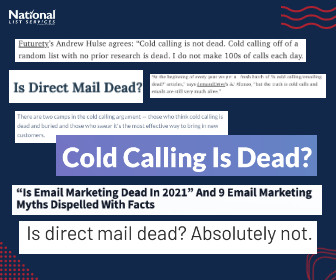
Why is direct mail so effective? It comes down to fact that we (humans) like getting mail. 41% of Americans of all ages look forward to getting their mail every day. We still want very real things in our hands, which is something totally lost in email inboxes or on social media. That tactile connection translates into 💰.
Cold Calling
Cold calling is another one of those things that’s been “on its way out” for years! Why is sticking around? At this point, an actual person to person conversation is a novelty and stands out against digital interactions. And sales, more than anything, based on connections and communications. It’s a lot easier to ignore an email than a ringing phone. It can also be harder to say no to a real person who you can actually hear.
If you add cold calling as part of your omnichannel marketing, work on your pitch, and be prepared to fail, you may be surprised at how effective it is!
